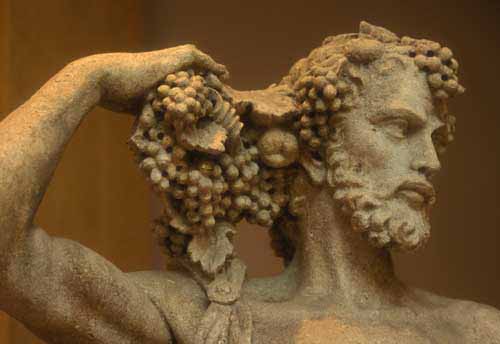Ancient Hellas is one of the oldest and most important wine-producing civilizations, with evidence of production dating back 6,500 years. Because of the climate, soil and the native vine stocks of the Hellenic islands, ancient Hellenic wine was of great quality. It was a major trade good throughout Europe, and was grown throughout the Hellenic nation--in what is now modern day Italy, Iberia, Sicily, and the south of France. People as far away as modern-day Austria and Russia, as well as many other ancient societies--like the Etruscans, the Phoenicians, the Celts, the Scythians and the Romans--were influenced to some extent by the ancient Hellenic wine making business and culture. But what sort of wines did they drink and how was it made?
The ancient Hellenes called the cultivated vine 'hemeris' (ἡμερίς), after their adjective for 'tame' (ἥμερος), differentiating it from its wild form. They practiced an early form of pigeage when grapes were ready for crushing: wicker baskets filled with grapes were placed inside wooden or earthenware vats with a rope or plank above. Vineyard workers grasped the rope for balance to crush the grapes with their feet, occasionally to the accompaniment of a flute played in a festive manner. After crushing, the grapes were placed in large pithoi, jars where fermentation took place.
Both Hesiod's writings and Homer's Odyssey include some of the earliest mentions of straw wine production: laying out freshly harvested grapes on mats to dry nearly to raisins before pressing. A wine made on Lesbos known as 'protropon' was among the first known to be made exclusively from free-run juice, drawn from grape clusters expressing their contents under their own weight. Other Hellenic innovations include the harvest of deliberately unripe grapes in producing a more acidic wine for blending. The boiling of grape must was discovered as another means of adding sweetness to the wine.
The Ancient Hellenes believed wine could also be improved by adding resin, herbs, spice, seawater, brine, oil and perfume.Ancient Hellenic wine was sweet and aromatic. One form--called Retsina--includes pine resin and has a very special, although acquired, taste. In ancient Hellas, the resin was only added to the wine because the lid of the amphorae were sealed with it, but modern Retsina has the resin added to it directly. The range of ancient Hellenic wine was broad; from inky black to dark red, red, light red, or white. It was never drunk undiluted; the ancient Hellens considered the drinking of undiluted wine to be barbaric.
In addition to its significance as a trade commodity, wine also served important religious, social and medical purposes in ancient Hellenic society. Wine, wine making and wine drinking was, almost needless to say the domain of the Theos of Wine Himself: Dionysos. The medicinal use of wine was frequently studied by the ancient Hellenes, including Hippocrates, who did extensive research on the topic. He used wine as a cure for fevers, to ease convalescence and as an antiseptic. He also studied the effect of wine on his patients' stool. Various types of wine were prescribed by ancient Hellenic doctors for use as an analgesic, diuretic, tonic and digestive aid. They were also aware of some negative health effects, especially those arising from the consumption of wine beyond moderation.
The ancient Hellenes called the cultivated vine 'hemeris' (ἡμερίς), after their adjective for 'tame' (ἥμερος), differentiating it from its wild form. They practiced an early form of pigeage when grapes were ready for crushing: wicker baskets filled with grapes were placed inside wooden or earthenware vats with a rope or plank above. Vineyard workers grasped the rope for balance to crush the grapes with their feet, occasionally to the accompaniment of a flute played in a festive manner. After crushing, the grapes were placed in large pithoi, jars where fermentation took place.
Both Hesiod's writings and Homer's Odyssey include some of the earliest mentions of straw wine production: laying out freshly harvested grapes on mats to dry nearly to raisins before pressing. A wine made on Lesbos known as 'protropon' was among the first known to be made exclusively from free-run juice, drawn from grape clusters expressing their contents under their own weight. Other Hellenic innovations include the harvest of deliberately unripe grapes in producing a more acidic wine for blending. The boiling of grape must was discovered as another means of adding sweetness to the wine.
The Ancient Hellenes believed wine could also be improved by adding resin, herbs, spice, seawater, brine, oil and perfume.Ancient Hellenic wine was sweet and aromatic. One form--called Retsina--includes pine resin and has a very special, although acquired, taste. In ancient Hellas, the resin was only added to the wine because the lid of the amphorae were sealed with it, but modern Retsina has the resin added to it directly. The range of ancient Hellenic wine was broad; from inky black to dark red, red, light red, or white. It was never drunk undiluted; the ancient Hellens considered the drinking of undiluted wine to be barbaric.
In addition to its significance as a trade commodity, wine also served important religious, social and medical purposes in ancient Hellenic society. Wine, wine making and wine drinking was, almost needless to say the domain of the Theos of Wine Himself: Dionysos. The medicinal use of wine was frequently studied by the ancient Hellenes, including Hippocrates, who did extensive research on the topic. He used wine as a cure for fevers, to ease convalescence and as an antiseptic. He also studied the effect of wine on his patients' stool. Various types of wine were prescribed by ancient Hellenic doctors for use as an analgesic, diuretic, tonic and digestive aid. They were also aware of some negative health effects, especially those arising from the consumption of wine beyond moderation.


No comments:
Post a Comment